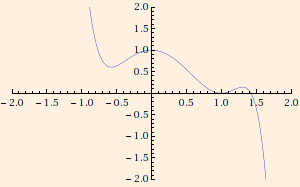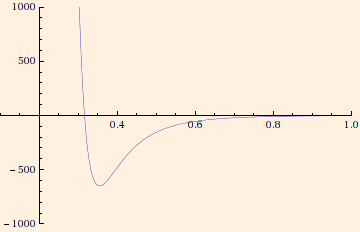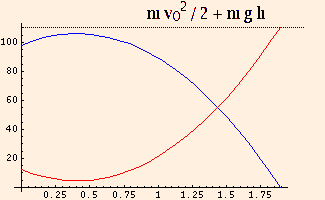
| (prev) | (top) | (next) |
Efforts to generalize the definition of work lead to massive confusion. Use the integral to determine the magnitude of the work,
and then decide if the work increases or decreases the energy of the object.
The gradient is normal to an equipotential "surface": a surface (or line or point) of constant U:
dU/dx = 0 at x = -0.5739, 0, 1 and 1.3059.
Dissipative forces (such as friction and drag) are not conservative.
For conservative forces, the dynamics is completely determined by the
potential, so knowing that
allows you to determine the forces (through the gradient) and therefore the equations of motion.
So in the absence of changes in energy caused by external forces (including dissipative forces), we have
conservation of energy:
In considering the energy of any object moving from an initial state to a final state, identify Ei = Ui + Ki and
Ef = Uf + Kf. If Ei > Ef, energy must have been lost because of dissipative work, and
= m ∫ a ⋅ v dt
= m ∫ dv/dt ⋅ v dt
= m ∫ v ⋅ dv
= m v2 / 2
Noether's theorem states that a system which has a Lagrangian formulation and a continuous symmetry will have
conserved quantities given by (in the case of our simple mechanical Lagrangian)
The principle of least action and Noether's theorem lie at the foundations of two of the most successful theoretical structures in physics:
the Standard Model of Particle Physics
and General Relativity.
Work and Energy
Note that if F is perpendicular to dx, no work is done by the force.
Energy (also measured in Joules) is a quality of matter, not a substance.
For most practical purposes, the concept of work is used to account for energy losses due to things like friction, or gains
in energy due to the application of some external force.
F = - (∂U/∂x, ∂U/∂y, ∂U/∂z)
The direction of the gradient is the direction of the greatest change in U with position.
≡ - ∇ U
Note that U is relative since addition of a constant leaves the force unchanged. U = 0 is often chosen to represent a
free particle (unaffected by the force), with negative values of U corresponding to a
bound particle (confined in space by the force). Also note that this implies that
U = - ∫ F ⋅ dx.

U(x) = (x2 - 1)2 - x5 + 2 x6 - x7
The last is the a generalization of the Van der Waals Potential,
combining a repulsive part and an attractive part to model the interaction energy between
two atoms (not in the same molecule). Here r is the distance between their nuclei. It is often used as the "12-6"
Lennard-Jones Potential U = a / r12 - b / r6:

K ≡ m v ⋅ v / 2.
ΔE = Workexternal.
Here, Workexternal is understood to include any forces not described by U.
ΔE = 0.
In this graph, corresponding to an object thrown upward off a cliff, U (blue) = m g y, K (red) = m v2 / 2, and U+K is a constant throughout
the object's trajectory:

Ui + Ki - (Uf + Kf) = Wdissipative.
If Ef > Ei, energy must have been gained by work done on the object by an external force not described by U, and
Uf + Kf - (Ui + Ki) = Wexternal.
When conserving energy between steps of a process, energy lost in one step to dissipative forces is not available for the next step.
P ≡ dE/dt
For non-dissipative external work, the integral of the power gives the change in kinetic energy. Assuming m and F are constant:
∫ (dW/dt) dt
= ∫ F ⋅ v dt
L = m v2 / 2 - U(x)
The principle of least action states that the action
I ≡ ∫ L dt
is a minimum for any system which can be described by a Lagrangian. Minimizing the action for our simple mechanical Lagrangian, we have
dL/dx - d(dL/dv)/dt = 0
or
- dU/dx - d(m v)/dt = 0
which is of course simply Newton's equation. The vast majority of physical systems can be described in this fashion, making the principle of
least action perhaps the closest thing we have to a unifying principle in physics.
dL/dv * v - L
or
U(x) + m v2 / 2
which is of course just the total energy. The continuous symmetry in this case is time translation invariance,
which simply means that the Lagrangian does not depend on time.
| (prev) | (top) | (next) |
©2011, Kenneth R. Koehler. All Rights Reserved. This document may be freely reproduced provided that this copyright notice is included.
Please send comments or suggestions to the author.